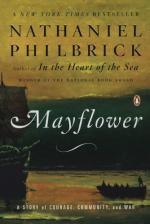|
This section contains 447 words (approx. 2 pages at 400 words per page) |

|
Mayflower Summary & Study Guide Description
Mayflower Summary & Study Guide includes comprehensive information and analysis to help you understand the book. This study guide contains the following sections:
This detailed literature summary also contains Topics for Discussion and a Free Quiz on Mayflower by Nathaniel Philbrick.
Mayflower: A Story of Courage, Community, and War by Nathaniel Philbrick explores the first fifty-five years of the Pilgrims' life in the New World. Philbrick particularly focuses on the social and economic relationships between the English and their Native American neighbors. The two groups evolve from distrust to a cooperative alliance to a bloody war within this short time frame. Their actions and beliefs would shape the development and structure of the country that would become the United States. Philbrick traces this history from the Pilgrims' departure from England to the death of Philip, the Pokanoket leader, in King Philip's War.
The Pilgrims sought religious freedom, which first led them to Leiden, Holland. However, they were afraid that their children were losing their English identity and the group made the decision to form a colony in the New World. They secured a patent and funding, but were forced to include individuals not part of their congregation, or Strangers. Sailing on the Mayflower, they arrived in the fall of 1621, unsure of what awaited them. They spent their first several months in the New World finding a settlement spot and beginning to build their colony.
Although the Native Americans and the Pilgrims distrusted each other in the beginning, with good reason due to past events between the English and Indians, Massasoit and William Bradford brought the two groups to an alliance. Without this, the Pilgrims would have perished their first year in America, from starvation, exposure, or attack. Both groups benefited from the implied protection of the other, although they also manipulated the alliance at times for their own benefit.
Yet, less than sixty years later, the English found themselves in a war with their Native American neighbors. In many ways, the English pushed too hard on the social and economic boundaries of the region. They humiliated Native leaders, collected land, distrusted Indians loyal to them, and forgot many of the lessons that their fathers and mothers had learned when they reached the New World. For their part, the Native Americans had grown tired of the humiliation and believed the English had killed the sachem, Alexander. The war would be one of the bloodiest in American history. King Philip's War would profoundly impact the region for years to come.
Philbrick argues that many of our notions about this time period fail to capture the complex events and motives. Whether the symbolizing the good of America in the first Thanksgiving or the evil of the English in their treatment of the Native population, the myths about the Pilgrims hide the overall humanity of the people involved. Both groups manipulated, cooperated, took, gave, killed, and were killed.
Read more from the Study Guide
|
This section contains 447 words (approx. 2 pages at 400 words per page) |

|



